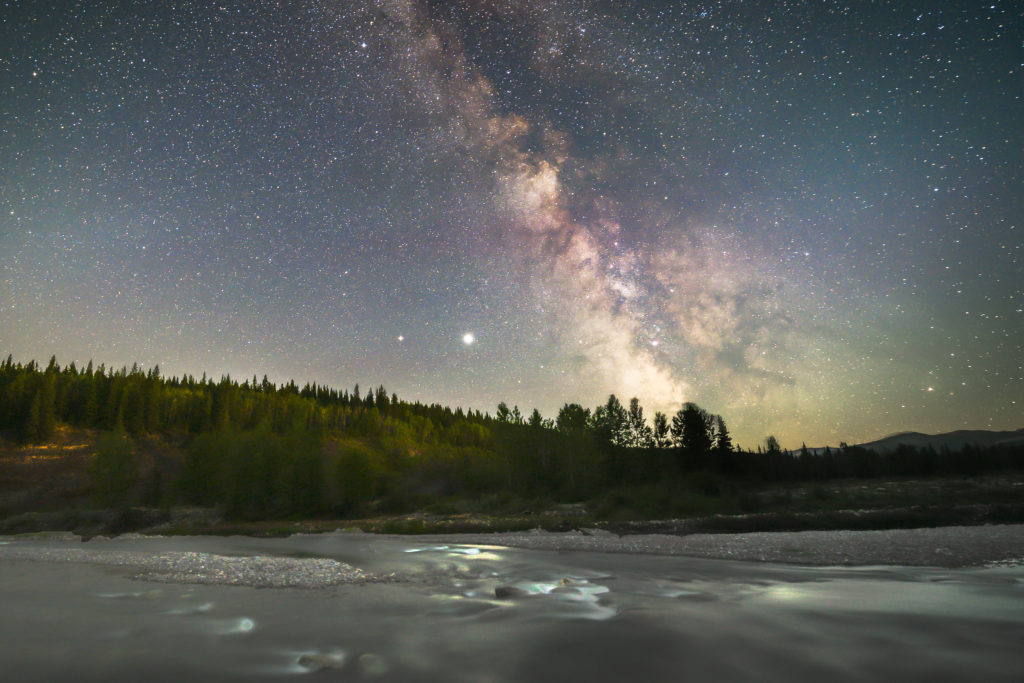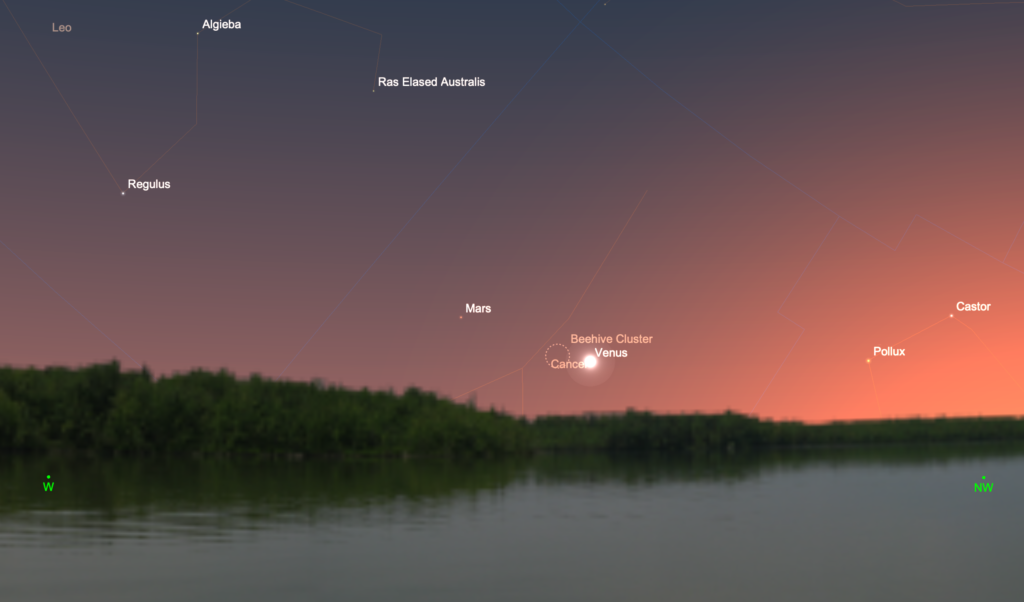
All the bright planets make an appearance this month. While Mars is as dim as it gets, the Red Planet appears alongside Venus and the Moon in the evening sky for a photogenic apparition. Jupiter and Saturn rise after midnight in the southeast, each planet slowly brightening and growing on its way to opposition next month. They are both spectacular in a telescope right now. And little Mercury makes a good apparition in the eastern morning twilight before the sun rises. While it’s mostly planets this month, don’t forget about the Milky Way emerging in the darkening east-southeastern sky. Turn your optics along this spectacular river of stars to glimpse the many clusters, nebulae, and star clouds in our part of the galaxy. Here’s what’s in the night sky this month…
1 July 2021. Last Quarter Moon, 21:11 UT

2 July. As evening twilight gets underway, look low over the northwestern horizon to spot Venus near the Beehive Star Cluster (Messier 44) in the constellation Cancer. Venus is plenty bright enough to see without optics, but a pair of binoculars help you glimpse the cluster. While Venus is well spaced from the Sun, it appears low over the horizon for northern-hemisphere observers. Observers south of the equator have an easier time spotting Earth’s ‘evil twin’, a planet similar in mass and size to our own, but completely different in term of its atmosphere and surface conditions. A lovely to behold at a distance, but it is no vacation spot.
4 July. Mercury reaches greatest western elongation 22o from the Sun. This speedy little world remains in the morning sky for most of the month, reaching peak brightness of magnitude -1.0 on July 18.
5 July. Earth reaches aphelion, the most distant point in its orbit from the Sun. The two bodies are 152,100,527 km apart today, about 3.4% farther than at perihelion in early January.
6 July. The constellation Taurus has worked its way around to the other side of the sky. It’s now rising in the east in the early morning sky. Today, the waning crescent Moon rises in Taurus between the Pleiades and Hyades star clusters.

8 July. Look for a slender waning crescent Moon in Taurus about 4o north of Mercury in the eastern early-morning twilight. The planet also lies within 0.5o of the 3rd-magnitude star zeta Tauri this morning. Mercury reaches its greatest elevation above the eastern horizon on July 9-10.
10 July. New Moon, 01:17 UT

11-12 July. Venus and Mars lie less than a degree apart low over the western horizon after sunset. At magnitude -3.9, Venus is by far the brighter of the two. On July 11, a slender crescent Moon lies about 5o north of the pair. On the following evening, the Moon moves about 8o to the east of the two planets near the 1st-magnitude star Regulus. Binoculars help you get a better view in the slowly darkening sky. Mars continues to sink towards the horizon as summer continues on its way to conjunction in October. It presents little detail in a telescope right now.
17 July. First Quarter Moon, 10:11 UT
21 July. Look to the west-northwest after sunset to see bright Venus just a degree from the star Regulus.
24 July. Full Moon, 02:37 UT

25 July. What are those bright stars near the Moon tonight? Those ‘stars’ are the planets Jupiter and Saturn. This is an excellent time to observe each planet in a telescope as they are slowly growing in size and brightness on their way to opposition next month. Jupiter rises about 10 p.m. local time by the end of July, while Saturn precedes it by about 45 minutes. Jupiter spans about 48” and shines at a brilliant magnitude -2.8, Saturn spans about 19” (without rings) and shines at magnitude +0.2 on its way to opposition on August 2.
27-30 July. The Delta Aquariid meteor shower peaks. This annual event favors observers in the southern hemisphere and southerly latitudes in the northern hemisphere, though all observers can see some of these slow-moving meteors. The Delta Aquariids appear to radiate from a point near the star Skat (delta Aquarii) in the constellation Aquarius. The shower peaks around July 27-30, but unlike most meteor showers, the Delta Aquarids lack a sharp maximum so meteors are visible from mid-July through early August. The maximum hourly rate can reach 15-20 meteors in a dark sky.
31 July. Last Quarter Moon, 13:16 UT